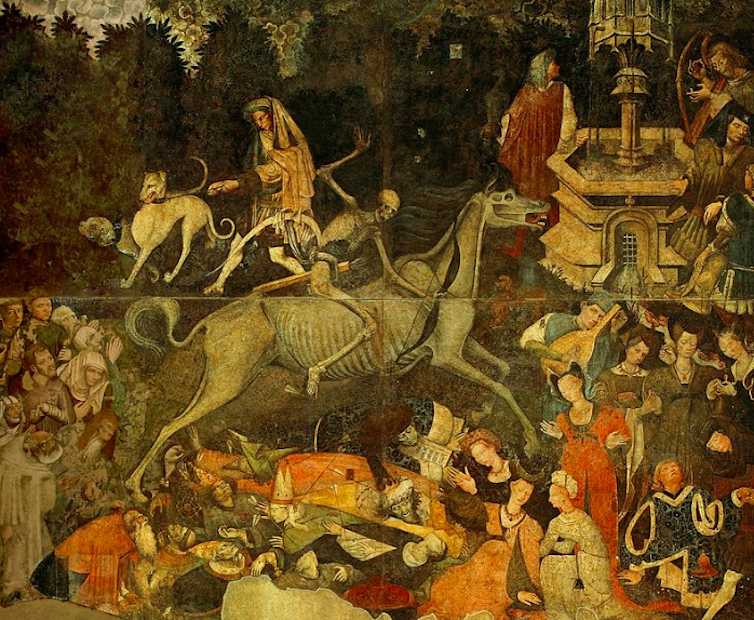Blog series Part 1: Covid 19 – A Crucial Inspection by Nandini Sen and colleagues
The effects of Covid-19 have been considerable and far-reaching. In this four-part blog series, Nandini Sen, Anusua Singh Roy, Jayanta Bhattacharya, and Subrata Shankar Bagchi explore the impacts of Covid-19 within an Indian context. The first piece outlines the methodology of their research, the second focuses on Covid-19’s impact on India’s informal economy, the third examines the relationship between the pandemic and gender-based violence, and the final piece takes a closer look at the mental health challenges postgraduate students face in this current climate.
During 1867-69, quarantine in the Suez Canal was quite stringent. For its obvious trade and economic interests, England maneuvered quarantine laws for cholera – a pandemic of the period. More than hundred years back, in the years of 1918-1919, colonialised India was shaken by a similar complex pandemic called the Spanish Flu. Upon witnessing so many deaths, Gandhi said at the time that he had lost his desire to live [1]. Currently the mystery virus comes in 2020.
Coronavirus outbreaks surge worldwide; research teams are racing to understand a crucial epidemiological puzzle — what proportion of infected people have mild or no symptoms and might be passing the virus on to others. Some of the first detailed estimates of these covert cases suggest that they could represent some 60% of all infections [2].
In the following series of blogs, we will contribute toward three relevant and related topics, including economic impact, gender-based violence (GBV), and the sociocultural including mental health impact on a community of postgraduate students due to this pandemic, focusing on evidences from India. In this section we discuss the methodology adopted in our analysis.
We have conducted a comprehensive desk review using grey (such as reports and documents from humanitarian agencies and news media) and academic sources. The process includes an extensive search of information including literature on economic impact, gender-based violence and socio-cultural including mental health related to the lockdown under pandemic circumstances. The search strategy uses broad search terms to include any relevant sources with reference to the contextual economic factors, GBV and socio-cultural including mental health conditions.
Secondary research that involves a narrative review [3] informs the statistical content of this study. The flexibility and exhaustive nature of narrative reviews [4] allows for exploratory analysis of the aforementioned metrics, in the absence of complete data. Literature search focusing on quantitative studies and reports has been conducted in order to collate statistics relating to the economic situation, gender-based violence, and socio-cultural and mental health outcomes as consequences of the Covid-19. This is supplemented by illustrative summaries and interpretations, elucidating known information, and underlining potential gaps for further work.
References
[1] J. Bhattacharya, ‘Coronavirus: An Episode of a Different life?’, (2020) Guruchandali (Bengali e social journal), Kolkata, India.
[2] J. Qui, ‘Covert coronavirus infections could be seeding new outbreaks‘, (Nature, 20 March 2020).
[3] R. Ferrari, ‘Writing narrative style literature reviews’, (2015) Medical Writing, 24(4), 230-235.
[4] A. Y. Gasparyan and colleagues, ‘Writing a narrative biomedical review: considerations for authors, peer reviewers, and editors,’ (2011) Rheumatology International, 31(11), 1409.
Blog Series part 2: Economic Impact of Covid 19: Migrant Labourers in India
In the context of the global pandemic of coronavirus, India’s migrant workers are facing the crisis of joblessness and homelessness within a dynamic influenced by population density, ‘policy-blindness’, ‘social nausea’,[1] and economic issues. This piece addresses the economic impact on migrant workers from the unorganised sectors in India after the Prime Minister giving only four hours’ notice in the first instance, imposed two phases of lockdowns in March 2020 and again in April 2020. The number of India’s internal migrants were estimated at a staggering 453.6 million [2] [3] as per the last census. This includes those who are employed in the informal sector, which constitute at least 80% of India’s workforce,[4] and those working as casual and cross-border labourers, accounting for one-third of all workers at the national level.[5] Such individuals represent a considerable volume of the workforce and it is imperative for the Government to ensure their safety and wellbeing.
The lockdown prompted a wave of mass migration across India, unlike anything seen since the Partition in 1947, as people began walking for hundreds of miles.[6] It resulted in people fearing the hunger more than the disease itself. The New York Times [7] reports the story of Pappu (32), who sees himself as doubly misfortunate, being vulnerable both to the disease and to acute hunger. Most migrants, having limited access to money or assets, little awareness of health and welfare services, or a solid understanding of their rights, face a sharp loss of equilibrium in their lives.[8] This is further reflected in the data on Covid-19 deaths that are not directly associated with the virus infection, but with the draconian actions of the lockdown – such as ‘suicide, due to lockdown, lathicharge, hunger, during migration etc.’.[9] A plot of non-virus deaths vs Covid-19 deaths [10] based on data collected from reliable news sources reveals a bleak testimony of the aftermath of the lockdown on vulnerable migrant workers. It shows a sharp rise in non-virus-related cumulative deaths from 27 March, with cumulative deaths not due to the virus remaining higher than that due to the virus for a span of about 2 weeks.
Uncertainty in the lives of workers, entrenched by hunger, and poverty set the scene for a rapid unfolding of the biggest migration ‘in India’s modern history’.[11] A stark illustration of how such workers are marginalised by government policy is provided. Although a financial aid package worth $22 billion was announced by the Government, it represents only 1% of India’s GDP,[12] far less than European countries whose economic responses to alleviate the Covid-19 crisis amount to more than 20% of their GDP.[13] In the country’s capital, New Delhi, the state government declared food relief measures for those who were ‘registered as beneficiaries under the food security law’, covering around 7.2 million (40%) of its population, and resulting in the potential exclusion of ‘millions of vulnerable families who are not on the Public Distribution System’ including a ‘large number of urban poor and migrants’.[14]
Leading economists Jean Dreze [15]and Jayati Ghosh [16] describe the lockdown as a disaster, and argue that the Government must take better care of its people. Ghosh further says, ‘We have never had a situation where the government has simultaneously shut down both supply and demand, with no planning, no safety net and not even allowing the people to prepare’. Massive logistical and imminent starvation challenges have been created for thousands of migrant workers in India whose lives were torn apart in response to the threat of the coronavirus pandemic UN report, 2 and 15 April 2020.[17] ‘With the money we have with us we cannot sustain ourselves more than two days and there is no sign of relief from government’, says Ram Singh, a ragpicker. Singh, along with others walking long distances testify they have lost their dignity in this crisis.[18]
The question remains, will food, wages, shelter, safety, medical empathy of migrant workers remain in limbo? Trade unions and social networks may need to collaborate in solidarity with migrant workers.
References
[1] A. Kumar, ‘Reading Ambedkar in the Time of Covid-19’, (2020) Economic and Political Weekly, 55(1), p. 34.
[2] A. Kundu and P. C. Mohanan, ‘Internal migration in India: a very moving story‘, (The Economic Times, 11 April 2017).
[3] S. Bansal, ‘45.36 crore Indians are internal migrants‘, The Hindu (2 December 2016)
[4] ‘Informal economy in South Asia‘, (International Labour Organization)
[5] Ministry of Labour & Employment, ‘Report on Fifth Annual Employment – Unemployment Survey (2015-16). Volume 1‘, (2016) Government of India.
[6] ‘Coronavirus: India defiant as millions struggle under lockdown‘, (BBC News, 28 March 2020)
‘Coronavirus lockdown sparks mass migration in India‘, (BBC News, 30 March 2020)
H. Ellis-Petersen, ‘India racked by greatest exodus since partition due to coronavirus‘, The Guardian, 30 March 2020.
[7] M. Ali-Habib and S. Yasir, ‘India’s Coronavirus Lockdown Leaves Vast Numbers Stranded and Hungry‘, The New York Times, 29 March 2020.
[8] K. Wickramage and others, ‘Missing: Where Are the Migrants in Pandemic Influenza Preparedness Plans?’, (2018) Health and Human Rights Journal, 20(1), 251-258.
[9] ‘Media Reports based on Non Virus Deaths‘, (DataMeet)
[10] ‘Non Virus Deaths‘, (Thejesh GN)
[11] M. Ali-Habib and S. Yasir, ‘India’s Coronavirus Lockdown Leaves Vast Numbers Stranded and Hungry‘, The New York Times, 29 March 2020.
[12] ‘India coronavirus: $22bn bailout announced for the poor‘, (BBC News, 27 March 2020)
[13] S. Amaro, ‘Germany is vastly outspending other countries with its coronavirus stimulus‘, (CNBC, 20 April 2020)
[14] A. Yadav, ‘India: Hunger and uncertainty under Delhi’s coronavirus lockdown‘, (Al Jazeera, 19 April 2020)
[15] J. Dreze, ‘Migrant workers treated badly, more needs to be done to help them now‘, (India Today, 14 April 2020)
[16] K. Thapar, ‘Coronavirus Lockdown has Already Done More Damage to Economy than Demonetisation‘, (The Wire, 24 March 2020)
[17] S. Datta, ‘India: Migrant workers’ plight prompts UN call for ‘domestic solidarity’ in coronavirus battle‘, (UN News, 2 April 2020)
[18] H. Ellis-Peterson,’”I just want to go home”: the desperate millions hit by Modi’s brutal lockdown‘, The Guardian, 4 April 2020.
Blog Series Part 3: Covid-19 and Gender-based Violence in India
Indian policy-makers appear to be more concerned by the lockdown’s impact on finances and the economy than on social effects such as gender-based violence against women.[1] At a time when women are already shouldering a higher proportion of the domestic burden during the lockdown, escalating tensions related to the crisis in resource and space are further aggravating gender-based violence behind closed doors. Denied access to traditional forms of support of family, friends, and doctors, the hanging threat of gender-based violence for these women remain inside their own homes. The National Commission for Women (NCW) have reported various offences against women, recording 587 complaints of domestic violence in the period 23 March -16 April – an almost 50% increase from the 396 complaints registered before the lockdown within the period 27 February-22 March.[2]
According to the National Family Health Survey (NFHS) carried out in 2015-2016, 33% of women admitted to having experienced domestic violence, but less than 1% sought police assistance,2 which suggests that even in ordinary times women are much less inclined to seek help from the authorities. These are far from ordinary times and it is not unlikely that women are in an even worse position to knock on doors for help against their abusers. Women’s organisations and activists reflect that had these abused women ‘known (about the lockdown) they would have tried to get out earlier and be at safer places’.[3]
The current crisis requires a gender lens, if we are to address the needs of those who are most affected by it. Across India, women are also shouldering the enormous burden of household chores.[4] The Organisation of Economic Cooperation and Development (OECD) reports that an average Indian woman spends almost 6 hours in unpaid chores per day, as opposed to their male counterparts who devote a meagre 51.8 minutes.[5]
Additionally, according to the WHO, ‘depressive disorders account for close to 41.9% of the disability from neuropsychiatric disorders among women compared to 29.3% among men’.[6] Research needs to be carried out on the short and long-term mental health repercussions, and more specifically, on the intensified impact of high-population density, poor water, sanitation, hygiene provision, and the inability to self-isolate on vulnerable working class women in the context of social and physical distancing. In India, vulnerable working-class women must fill in water at the crowded common tap, use public latrines, or sell vegetables in marketplaces making them more vulnerable to the disease. Frontline staff involved in India’s battle against the coronavirus comprise an astounding number of female community health workers – roughly 900,000. With a remuneration of only ₹30 (less than $1) per day however, ‘they are poorly paid, ill-prepared and vulnerable to attacks and social stigma’.[7]
Loss of wages, jobs, boredom and withdrawal from alcohol and drugs, lead men to direct their rage on women in the household.4 Worse still, women are now bound within the four walls of their homes with their abusers. In response to the alarming incidence of gender-based violence during the pandemic, the UN chief has requested governments of different countries including India to treat legal and medical affairs related to gender-based violence as emergency services.[8]
Gender-based violence related to lockdown is entirely dependent on access to social, economic, and political power.[9] In this regard, the situation is particularly severe for women in India. 81% are employed in the informal sector[10] which ‘is the worst hit by the coronavirus imposed economic slowdown’,[11] while only 29% of those with internet access are females[12], which acts as a deterrent against mental support and financial aid in these tough times.
Studies of past pandemics and current violence on women under lockdown should inform policy makers of different humanitarian bodies to develop mitigation measures (e.g. health, education, child-protection, security and justice, job creation, and humanitarian responses) to efficiently respond to violence against women and girls.[13]
References
[1] N. Lal, ‘India’s “Shadow Pandemic”, Domestic violence in India surges during the COVID-19 crisis‘, (The Diplomat, 17 April 2020).
[2] S. Rukmini, ‘Lockdown with Abusers: India Sees Surge in Domestic Violence‘, (Al Jazeera, 18 April 2020).
[3] ‘Domestic abuse cases rise as COVID-19 lockdown turns into captivity for many women‘, (Deccan Herald, 31 March 2020).
[4] M. Gupte and S. Dalvie, ‘The gendered impact of COVID-19 in India‘, (The Week, 9 April 2020).
[5] A. Khullar, ‘Gender analysis missing from India’s coronavirus strategy‘, (Deccan Herald, 9 April 2020).
[6] ‘Gender and women’s mental health‘, (World Health Organization).
[7] ‘India coronavirus: The underpaid and unprotected women leading the Covid-19 war‘, (BBC News, 17 April 2020).
[8] L. Deb Roy, ‘Domestic violence cases across India swell since coronavirus lockdown‘, (Outlook, 7 April 2020).
[9] A. Castro and P. Farmer, ‘Understanding and Addressing AIDS-Related Stigma: From Anthropological Theory to Clinical Practice in Haiti’, (2005) American Journal of Public Health, 95(1), 53-59.
[10] International Labour Organization, ‘Women and Men in the Informal Economy: A Statistical Picture (3rd ed.)‘, (International Labour Organization, 2018).
[11] B. Kamdar, ‘India’s COVID–19 Gender Blind Spot. The Diplomat‘, (The Diplomat, 27 April 2020).
[12] United Nations Children’s Fund, ‘Children in a digital world‘, (UNICEF, 2017).
[13] ‘Why we need to talk more about the potential for COVID -19 to increase the risk of violence against women and girls‘, (Social Development Direct, 18 March 2020).
Blog Series Part 4: A Tale of Students in Higher Education in India and Abroad
The outbreak of COVID-19 has brought India to the brink of a catastrophic disaster which has far-reaching consequences on the Indian economy, well-being, and education. Students in higher education (HE) are shrouded within the cloud of uncertainty, frustration, dejection, and discouragement related to mental health conditions and a fear of financial bankruptcy after leaving their parental care. Higher education is not a priority of the Indian government, as is evident from the 2020-21 budget allotment towards it, a meagre 1.3% of the total expenditure.[1] Therefore, the apprehension of further neglect of students in HE is gaining more ground during this period of resource scarcity. The plot thickens as we see that in this pandemic the Reserve Bank of India has injected huge funds to revive the sick economy by giving incentives to the financial sector, industries, and businesses,[2] however simply forgetting to respond to the crisis of the students in HE.
Following guidelines laid out by the University Grants Commission and other apex education bodies, Covid-19 has led to the temporary closure of approximately 1000 universities and 40,000 colleges, impacting 37.5 million enrolled candidates and 1.4 million employed faculty.[3] Classroom teaching, which is the backbone of teaching within Indian universities, is withheld indefinitely. Online teaching efforts initiated by a few teachers are creating a digital divide among students as high-speed internet connection may be a dream for several students in higher education. The sudden closure of colleges and universities has caused the academic calendar to become completely chaotic, resulting in cancellation of examinations and students’ progress. The Central government has stopped research funds for basic research, a situation that is likely to be exacerbated in the aftermath of the pandemic. For instance, IIT Delhi is the first HE institute in India to obtain a mandate from the Indian Council for Medical Research for conducting polymerase chain reaction tests for Covid-19.[4]
The plight of female students is particularly severe in the current situation. This lockdown has resulted in cascading effects in the households of these students. Many are contemplating early exit from higher education in order to support their families. Female students are facing pressures to get married as soon as possible since their parents are no longer prepared to wait ‘indefinitely’. Gender-based inequalities are further compounded by an increased pressure on female students to perform household chores and their increased vulnerability to domestic abuse.
Lack of clarity around future employment and the climate of uncertainty have aggravated mental health issues. If the Government ignores the well-being of HE students and fails to provide mitigating measures, the Indian social fabric, economic development, research-based knowledge expansion, and gender-equality will be destroyed. It is unlikely that these students will be in a position to question state authority, let alone ask for what they might be entitled to. They face a lonely journey with little financial support, whereas their counterparts in Western countries such as the UK and Germany might receive financial and emotional support from their Universities or Governments.[5]
Equally worryingly, thousands of international Indian HE students, for example in the UK, are also facing the severe consequences of the current public health measures. They are unable to leave the UK due to the lockdown and are dependent on food charities due to financial hardship.[6] They have been made redundant from their part-time jobs and cannot meet basic living costs. [6] The Indian National Students’ Association and National Indian Students Alumni Union (NISAU) are receiving persistent calls from a huge number of students (3000) who request for food and accommodation. [6] Both organisations are trying to provide solutions and distribute food to stranded students from India. Labour MP for Ealing Southall, wrote to the UK education secretary, calling for universities to arrange money and minimum services from hardship funds, which are often discriminatory, for international students. [6] A few UK Universities and NGOs like NISAU are reaching out to support and help international Indian students tackle their challenges of accommodation, mental health, and food. [6]
References
[1] S. Alexander and N. Kwatra, ‘In fight against coronavirus, India’s universities have lagged far behind China’s‘, (Live Mint, 6 April 2020).
[2] ‘RBI Announces ₹ 50,000 crore Special Liquidity Facility for Mutual Funds (SLF-MF)‘, (Reserve Bank of India, 27 April 2020).
[3] KPMG, ‘Higher education in India and Covid-19‘, (KPMG, 2020).
[4] J. Lau, ‘India’s IITs join Covid-19 fight‘, (Times Higher Education, 29 April 2020).
[5] A. Packham, ‘“I can’t afford rent”: the students facing hardship during lockdown‘, The Guardian (24 April 2020).
[6] A. Fazackerley, ‘Indian students trapped in UK by coronavirus “actually starving”‘, The Guardian (1 May 2020).
This blog series was originally published by Justice in Global Health Emergencies & Humanitarian Crises: https://www.ghe.law.ed.ac.uk/blogs/
Dr Nandini Sen received her PhD at University of Frankfurt. She is a visiting research scholar at School of Social Sciences, Heriot Watt University, and an Associate of the Centre for South Asian Studies (CSAS) at the University of Edinburgh. since 2014 Her academic article Women and Gender in Rabindranath Tagore’s Short Stories from Anthropological Perspectives Challenging Kinship and Marriage was published in Anthropological Journal of European Culture in November 2016. Her book, South Asian Urban Marginalisation: A Waste-Picker Community in Calcutta, India., Routledge/Taylor and Francis (2018) has fetched both fame and critical reviews by academic colleagues and academics.
Dr Anusua Singh Roy is a Postdoctoral research fellow, Statistician at the School of Health Sciences at Queen Margaret University. Research interests include the use of national data sets in longitudinal, cross-sectional and survival probabilistic modelling to address health related and participation outcomes in children with disabilities and individuals with severe mental illness.
Subrata Shankar Bagchi is the Chair Professor in Anthropology at University of Calcutta and researcher on various socio-cultural issues in India.
Jayanta Bhattacharya by training a physician, did his PhD on history of medicine. He has widely published in the field of alternative medicine. He is a medical activist from India. He is the reviewer of the Bulletin of the WHO, Graduate Journal of Social Science, Social History of Medicine, Indian Journal of History of Science, Indian Journal of Medical Ethics and others.




